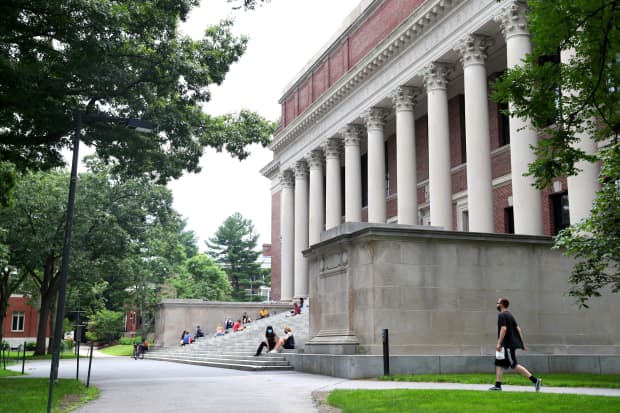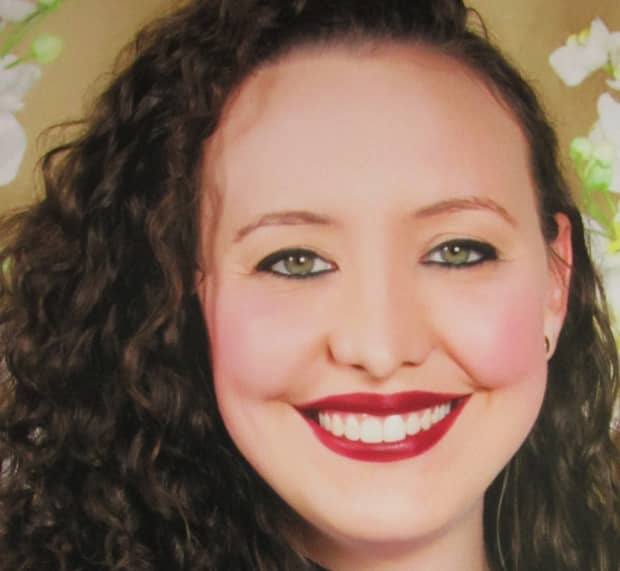This post was originally published on this site

The Trump administration recently rescinded guidance that would have banned international students from studying remotely in the U.S. as part of a settlement in a lawsuit filed by Harvard, pictured here, and the Massachusetts Institute of Technology. (Photo by Maddie Meyer/Getty Images)
Maddie Meyer/Getty Images
Colleges and their international students experienced some surprise relief this week when the Trump administration rescinded guidance that would have banned international students from taking a fully online college course load and remaining in the U.S.
The decision was the reversal of a policy announced last week that sent students and colleges scrambling as they prepare for a fall semester unlike any other. The initial announcement from U.S. Immigration and Customs Enforcement came amid pressure from the Trump administration for schools and universities to reopen this fall.
Just hours before ICE released its initial guidance, Harvard University and other prominent colleges had announced they would be holding their fall semesters remotely as a way to keep students and faculty safe amid the coronavirus pandemic. The reversal of that guidance on Tuesday came as part of a settlement between the Trump administration and Harvard and the Massachusetts Institute of Technology, which both sued over the policy.
Almost immediately after announcing that international students wouldn’t be able to stay in the U.S. if they studied remotely, the Trump administration faced pressure from colleges, state law enforcement officials and the business community to walk back the rule.
Now these groups are cheering the result of their advocacy. But uncertainty around international students’ academic careers during the pandemic remains, particularly for those students slated to start their education this fall, said Miriam Feldblum, the executive director of the Presidents’ Alliance on Higher Education and Immigration, a coalition of university officials focused on immigration policies’ impact on higher education.
Continuing international students who returned to their home countries during the pandemic are also staring down challenges coming back to the U.S. to continue their studies, given the COVID-related restrictions on travel.
Beyond the immediate precariousness of international students studying at U.S. institutions, ICE’s initial announcement created “lasting damage,” Feldblum said.
“There’s no doubt that the cumulative effect of the varied and numerous immigration measures undermining the ability of international students to come to the U.S., to work after graduating from their institutions, the measures affecting their ability while enrolled — all of these measures have a rippling effect of making the U.S. a less-welcoming environment,” she said.
MarketWatch spoke with a few international students about their experiences during the pandemic and their reactions to the government’s initial guidance and decision to rescind it.
Abdo Al-Rayyis

Abdo Al-Rayyis is studying at Lewis & Clark College.
Soon after Abdo Al-Rayyis first arrived in the U.S. for high school from the Kurdish region of Iraq, he started taking advantage of the rights afforded to him in this country.
“Most important would be freedom to speak my mind,” Al-rayyis said, “that was a totally new right for me here. I started talking about things that I wasn’t able to talk about at home,” like political figures, for example, he said.
Just a few years later, Al-Rayyis, a rising junior at Lewis & Clark College in Portland, Oregon, has his own satire show he’s been performing on campus — with a pandemic-induced pause of course — and streaming on YouTube GOOGL, -0.75%. He describes the performance, called Abdo’s Late Show, as, “Middle Eastern issues from a Middle Eastern perspective with a twist of comedy.”
“Other than the fragile, vulnerable position I have as an international student here, the experience has also been positive in many regards,” Al-Rayyis, 20, said of his time studying in the U.S.
Al-Rayyis’ position in the U.S. felt particularly tenuous last week when ICE announced that international students would have to attend some classes in person this fall or leave the country.
Navigating the pandemic as an international student had already been challenging. He’d been confronted with the question of whether to travel home and put himself and his family at risk as the country and colleges locked down.
Ultimately he decided to stay put at his school, becoming one of the more than 251,000 international students on campus during the spring semester, according to the Institute of International Education. But after school ended, Al-Rayyis wasn’t sure where he would go; ultimately he was lucky to find a family in Boston willing to host him for the summer.
After the government walked back its guidance on international students studying remotely this week, Al-Rayyis feels like he has more options. Now he is going to make his plans for the fall based on what feels safest. He’s deciding between returning to his college campus or studying from somewhere else in the U.S. He isn’t comfortable with the idea of international travel during the pandemic.
“I definitely feel freer now,” he said, shortly after the decision was announced.
Though the climate towards international students in the U.S. still isn’t ideal, the government’s decision to rescind its initial policy has Al-Rayyis feeling optimistic, he said.
“We spammed the federal government with the lawsuits — they were spammed into submission,” he said. “This just gives me hope for other groups who might be vulnerable. They could use the same attention and help.”
Debadrita Jana
One of the things that drew Debadrita Jana to the U.S. to pursue her Ph.D. in geology was the opportunity to be exposed to brilliant minds from all over the world.
She’s felt welcomed by her academic and broader community, but there are moments when her existence in this country feels precarious. One of those moments came last week when ICE announced its guidance prohibiting international students studying remotely from staying in the U.S.
“When things like this happen, it’s kind of pointed out, that ‘OK, you do not belong here,’” said Jana, who is from Kolkata, India. “It is kind of stressful to be in that situation and to be reminded constantly that your status can change at any time.”
ICE’s announcement last week came during an already stressful period: a global pandemic that shifted Jana’s routine at Rice University in Texas. She adjusted initially to not being able to come into the lab to do work that would help her move towards completing her degree. Now Jana can access the lab with a mask at specific times to ensure it’s not too crowded for social distancing.
Jana’s adapted to the new reality, but, like many, she’s been drained by the length of the pandemic. “Around March and April I was still like, ‘We are in lockdown, things will start to get better by the end of May, June,’” she said. “It’s already July and there’s no end in sight. It’s depressing to deal with on a day-to-day basis.”
ICE’s decision to reverse its guidance this week put Jana somewhat at ease. But the experience made her more aware of the issues surrounding other immigrant students in the U.S., including undocumented students. These students are able to attend college, but face restrictions on financial aid and constant uncertainty about their ability to stay in the country.
Jana said she was also heartened to see universities stand up for international students, but she worries about what will happen if, in the future, they don’t take that step.
“While this is definitely a relief, I feel like it is a temporary relief,” Jana said of ICE’s decision to reverse its guidance. “The current administration has shown time and again that it is not particularly welcoming to foreigners — it is quite the opposite, I feel.”
Leticia Cobra Lima

Leticia Cobra Lima is a Ph.D. student at University of California, Santa Barbara.
For Leticia Cobra Lima, ICE’s decision to reverse its guidance brought some security back to her family’s plans, but the damage from the initial announcement can’t be undone.
“The desired effect was to install instability with whoever is living here who is not from the U.S.,” she said. “It was a very cruel and very arbitrary decision and I’m glad it’s down, but the idea that it even got out and it was made public, already to me feels like an attack on international students.”
Cobra Lima, 31, is a third-year Ph.D. student in history of art and architecture at the University of California, Santa Barbara. The “unparalleled opportunities” for graduate work in the U.S. drew Cobra Lima here for her studies. The vibrant Latinx and Latin American communities in Southern California, access to adequate housing, decent-paying stipends, and resources to help with food security made Cobra Lima feel welcome when she arrived.
But the pandemic immediately reminded her of the precariousness of her status in the country. As universities were encouraging students to go home at the beginning of the pandemic, Cobra Lima and her husband decided to remain in the U.S. instead of returning to her native Brazil.
It turned out to be the right decision; the U.S. imposed a travel ban on Brazil in May, which would have meant Cobra Lima and her husband couldn’t return to the U.S. But they haven’t seen their families in nearly a year.
For the week the ICE guidance was in place, Cobra Lima and her husband weren’t sure about their future. Her husband is scheduled to start a Ph.D. program at the University of Michigan in the fall, but the idea of trying to move there in the midst of a pandemic so he could attend classes in person and retain his visa status seemed daunting.
Now they’re able to stick to their original plan — stay in Santa Barbara until Cobra Lima completes her exams in September and then begin the process of moving to Ann Arbor. “We’re very much in a more comfortable position now and I’m feeling very relieved that this whole thing is almost over,” she said. “My mom said she was praying for it to happen.”

